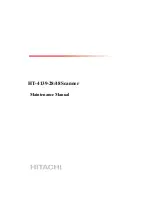
Easier to Read BCD396T/UBCD396T Digital Scanner Manual
Your scanner allows you to search for a local NOAA weather broadcast and set it to alert when a SAME weather alert is broadcast on a NOAA weather channel. You can
also program FIPS codes into the scanner and use weather priority that will check the weather channel every 5 seconds for a weather alert signal. For a table of all the
alerts and the code meanings,
.
To Edit Weather Options
press
Menu
. Scroll to '
WX Operation
' and press
E/yes
.
Or
, in scan or search modes, press
Hold
to hold on any channel.
Press and hold
Func
then press
2/(WX)
.
Scroll to the settings and options below and press
E/yes
. Press
Scan/Srch
to return to scanning when done with editing.
Note:
The items below do not follow the radio's menu order because (IMHO) they should be in the following order to properly setup and use the weather operation
features.
Weather Scan
The scanner starts scanning the preprogrammed weather frequencies and stops on the first good signal. If the signal is lost, the scanner resumes
searching for another weather transmission.
Scroll to '
Weather Scan
' press
E/yes
.
Press
Scan
to exit.
Weather Alert Priority
Turning the weather alert priority feature on allows the scanner to check the weather channels every 5 seconds for a 1050 Hz weather alert
signal and still scan or search. If you should receive an alert, you will hear a loud warbling then the weather channel audio. You will see
WX
in the display when Weather
Alert Priority is on.
Warning!
If you receive an alert it will be at
FULL
volume.
Scroll to '
WX Alt Priority
' and press
E/yes
.
Scroll to
On
and press
E/yes
.
Programming SAME Groups
SAME (Specific Area Messaging System) is a system developed by the National Weather Service to reduce the number of alerts
received by consumers by allowing them to hear alerts only for the county(ies) they are interested in. Each alert contains information about the type and severity of the
alert, as well as the specific geographic locations affected by the alert. In addition, certain special regions and wildcard settings can be assigned. Your scanner can
receive all SAME alert signals broadcast within about a 50-mile radius of where you installed it.
To receive SAME alerts and broadcasts about weather occurring only in particular counties within that area, you can program up to
5 (tagable) groups of 8 FIPS
codes
(40 codes) into the scanners memory. This lets you avoid hearing an alert that applies to an area within a 50-mile radius but not necessarily to your county or
parish.
For the purpose of broadcasting weather information, the NWS has divided the United States into regions by state and county (or parish, where applicable) then assigned
a 6-digit FIPS code to identify each county or parish. For example, the code for Tarrant County, Texas, is 048439. The first digit in a FIPS code identifies the county
subdivision, the next two digits identify the state, and the last three digits identify the county or parish. Most FIPS codes begin with 0, which means the code represents an
entire county. The NWS, however, plans to eventually subdivide some large counties. When that happens, each subdivision will be assigned a digit from 1-9, resulting in
codes such as 148439, 248439, and so on.
To obtain the FIPS code for the location where you installed your scanner call the NWS toll free at 1-888-697-7263 (follow the instructions you hear) or see
the United States and its Possessions.
FIPS codes are in the format nSSCCC:
n
: A special subcounty designator. For an entire county, use 0.
http://marksscanners.com/396/396.shtml (40 of 51)8/17/2010 10:11:40 PM











































